Bordar productos para la cabeza puede convertir sombreros y gorras simples en impresionantes, artículos personalizados. Whether you’;Si eres un principiante que busca explorar técnicas básicas de bordado de sombreros o un bordador experimentado que busca dominar métodos avanzados..
Esta guía lo guiará a través de las habilidades esenciales necesarias para crear diseños de calidad profesional en diversos artículos para la cabeza..
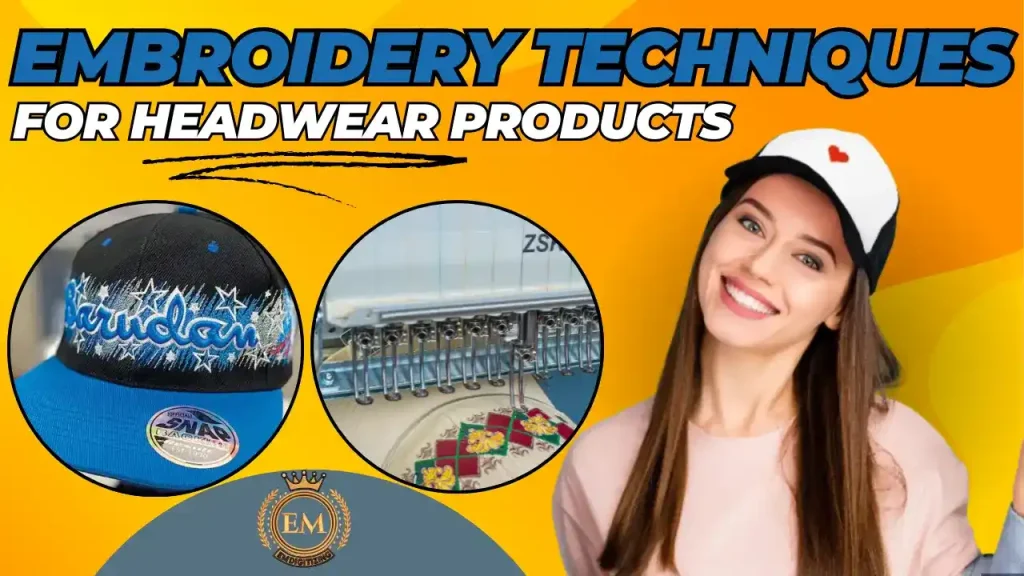
Técnicas de bordado para productos de sombreros: De lo básico a lo avanzado
Seleccionar el gorro ideal para bordar
El primer paso en el bordado es elegir el gorro adecuado.. Cada tipo tiene sus propiedades únicas que pueden mejorar los resultados de su bordado.:
- Gorros: Hecho de tejido de punto, Los gorros son suaves y flexibles., haciéndolos ideales para diseños que requieren elasticidad. Funcionan mejor con negrita., simplistic designs that highlight the fabric’;textura.
- gorras: Conocido por su frente rígido y su broche ajustable en la parte posterior., snapbacks ofrecen un piso, superficie estable para diseños complejos y son muy populares en la moda urbana.
- Gorras de béisbol: Estas gorras son una opción clásica para bordar., con un panel frontal suave que es perfecto para logotipos y diseños detallados que requieren una colocación precisa de las puntadas.
- Sombreros de cubo: Con su ala envolvente, Los sombreros de pescador ofrecen más superficie para mostrar diseños creativos tanto en la copa como en el ala., haciéndolos versátiles para looks casuales y elegantes..
- Gorros De Camionero: Caracterizados por su respaldo de malla y su panel frontal sólido, Las gorras de camionero son excelentes para los atrevidos., diseños vibrantes que destacan.
- Viseras: Las viseras son las más fáciles de bordar debido a su parte superior abierta y su amplia zona frontal., ideal para logotipos o mensajes promocionales.
Técnicas fundamentales de bordado de sombreros
Para empezar, debes entender estas técnicas fundamentales:
- Bordado Plano
- Letras en sombreros
- Lámpara de pared técnica
1. Bordado Plano
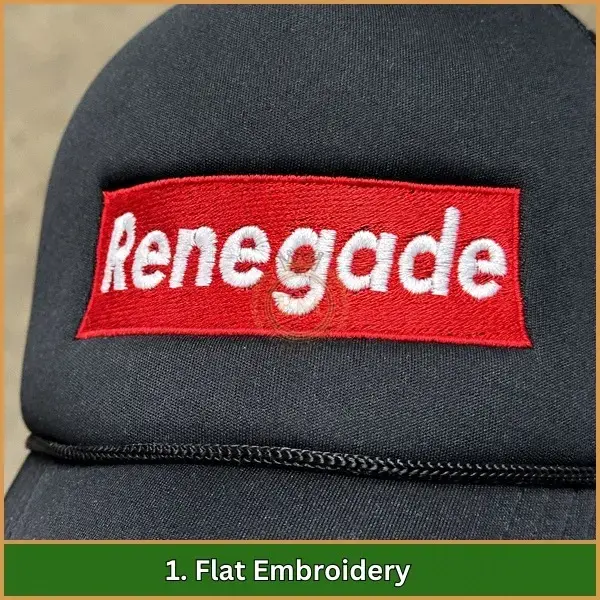
El bordado plano es un método en el que los diseños se cosen directamente sobre la tela del sombrero., creando una superficie bordada plana y suave.
Es ampliamente utilizado para logotipos., texto, y diseños gráficos básicos en productos de sombrerería..
Beneficios:
- Versátil: Adecuado para una amplia gama de diseños., desde logotipos simples hasta gráficos detallados.
- Acabado profesional: Produce limpio, diseños pulidos que lucen profesionales y refinados.
- Durabilidad: El bordado plano se mantiene bien con el tiempo., especialmente en sombreros de uso frecuente como gorras.
Características clave:
- Tipos de puntada: Los tipos de puntadas comunes en el bordado plano incluyen puntadas satinadas para bordes suaves, Rellenar puntadas para cubrir áreas más grandes., y puntadas continuas para líneas o contornos detallados.
- Flexibilidad de diseño: Funciona bien tanto con diseños simples como complejos., aunque los diseños deben digitalizarse adecuadamente para garantizar los mejores resultados.
- Compatibilidad de telas: El bordado plano se puede realizar en una variedad de telas., incluido el algodón, poliéster, y mezclas. Es importante hacer coincidir el tipo de aguja e hilo con el tejido para evitar dañarlo..
- Precisión: El bordado plano requiere una digitalización precisa del diseño para garantizar que las puntadas estén limpias y colocadas correctamente..
2. Letras en sombreros
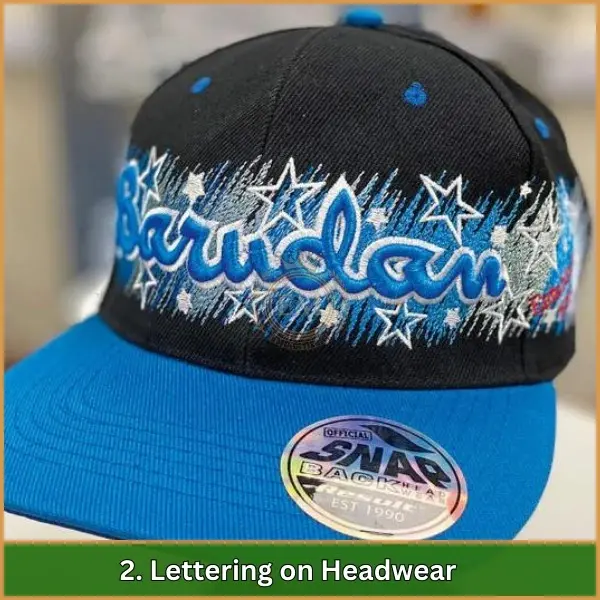
Las letras implican bordar texto en sombreros., convirtiéndola en una de las técnicas más populares para personalizar productos de sombreros..
Ya sea agregando un nombre, un eslogan de marca, o un logotipo, el lettering aporta un toque personal y profesional a gorras y sombreros.
Beneficios:
- Personalización: Perfecto para pedidos personalizados como monogramas, marca, o artículos promocionales.
- Versatilidad: Funciona bien en varios tipos de sombreros., desde gorras de béisbol hasta gorros.
- Oportunidades de marca: Las letras en los sombreros son una excelente manera de mostrar los nombres de las empresas o los logotipos de los equipos..
Características clave:
- Selección de fuente: Elige claro, fuentes legibles que se adaptan al tamaño del gorro. Las fuentes sans-serif suelen ser ideales para textos pequeños o densos..
- Tipo de puntada: Las puntadas satinadas se usan más comúnmente para letras, ya que crean una textura suave., mirada pulida. También aportan claridad, especialmente cuando se utilizan fuentes en negrita.
- Escalada: Las letras con la escala adecuada garantizan que no sean demasiado pequeñas ni estén distorsionadas., especialmente en superficies curvas como tapas.
3. Lámpara de pared técnica
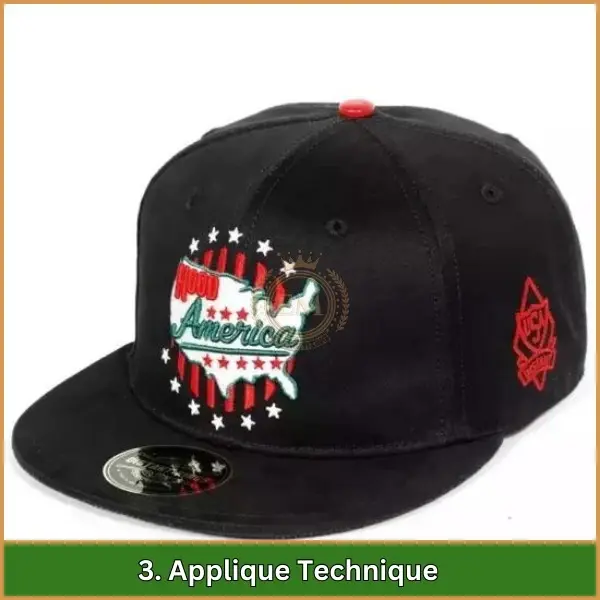
La aplicación consiste en coser un trozo de tela sobre la tela base del sombrero..
Esto añade profundidad, textura, y contraste con el diseño, haciéndolo un favorito para los más grandes, patrones más atrevidos.
Beneficios:
- Impacto visual: Crea un diseño más dinámico y visualmente interesante al superponer diferentes tejidos..
- Textura y contraste: Agregar capas de tela puede generar contraste en textura y color., haciendo que los diseños destaquen.
- Eficiencia de tiempo: Los apliques pueden cubrir áreas más grandes con menos costuras en comparación con los diseños completamente bordados., ahorrando tiempo.
Características clave:
- Selección de tela: Elige telas como fieltro., algodón, o satén que ofrecen contraste con el material del sombrero.. La tela debe ser fácil de cortar y manipular..
- Puntadas: Los bordes del aplique generalmente están terminados con una puntada en zigzag o satén., asegurando que la tela esté bien sujeta y que el diseño esté limpio, bordes afilados.
- Durabilidad: El aplique añade una capa extra de tela., proporcionando durabilidad a la sección bordada mientras crea negrita, diseños coloridos.
Técnicas intermedias para mejorar el detalle de sombreros
Once you’;Se siente cómodo con las habilidades básicas., Estas técnicas intermedias pueden añadir estilo a tus proyectos.:
- Encaje independiente
- Técnicas de monogramas
- 3Bordado de soplo D
1. Encaje independiente
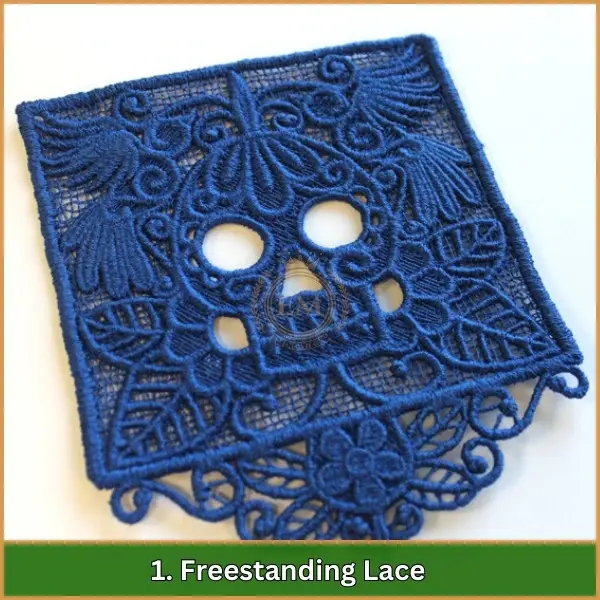
El encaje independiente es un delicado tecnica de bordado donde los diseños de encaje se cosen sobre un estabilizador soluble en agua. Una vez que se completa la costura, el estabilizador se lava, dejando atrás un patrón de encaje bellamente bordado.
Beneficios:
- Diseño elegante: Ideal para agregar complejos, elementos decorativos para productos de sombrerería, especially for women’;s sombreros o accesorios de novia.
- Uso versátil: Se puede aplicar a varias partes del sombrero., como el ala o la corona, añadiendo un toque único al diseño general.
- No se requiere base de tela: Crea una estructura de encaje independiente que no necesita coserse a otra tela..
Características clave:
- Estabilizador soluble en agua: El estabilizador se disuelve en agua., permitiendo que el encaje se sostenga por sí solo.
- Patrones complejos: El encaje independiente funciona bien con diseños complejos., floral, o diseños decorativos, perfecto para añadir un toque elegante a los sombreros.
- Solicitud: El encaje se puede utilizar como acentos o adornos., convirtiéndolo en una opción versátil para mejorar el diseño.
2. Técnicas de monogramas

Los monogramas implican bordar iniciales o nombres completos en sombreros., ofreciendo un toque personalizado a los sombreros. Desde escrituras elegantes hasta letras mayúsculas modernas, los monogramas añaden un elemento elegante y personalizado a cualquier diseño.
Beneficios:
- Personalización: Ideal para pedidos personalizados, dándole al sombrero un toque único, sentimiento personal.
- Variedad de estilos: Los monogramas ofrecen una variedad de estilos de fuente, desde lo clásico y formal hasta lo moderno y casual, permitiéndole adaptar el diseño a las preferencias del cliente.
- Uso versátil: Funciona bien en todo tipo de sombreros., incluyendo tapas, gorros, y viseras.
Características clave:
- Variedad de fuentes: Puedes elegir entre una amplia selección de fuentes., dependiendo del estilo que quieras lograr.
- Tamaño y ubicación: El tamaño y la posición adecuados de las iniciales son esenciales para garantizar que luzcan proporcionadas y elegantes en el sombrero..
- personalización: Los monogramas permiten obsequios personalizados o promoción de marca., haciéndolo muy popular para pedidos corporativos e individuales..
3. 3Bordado de soplo D
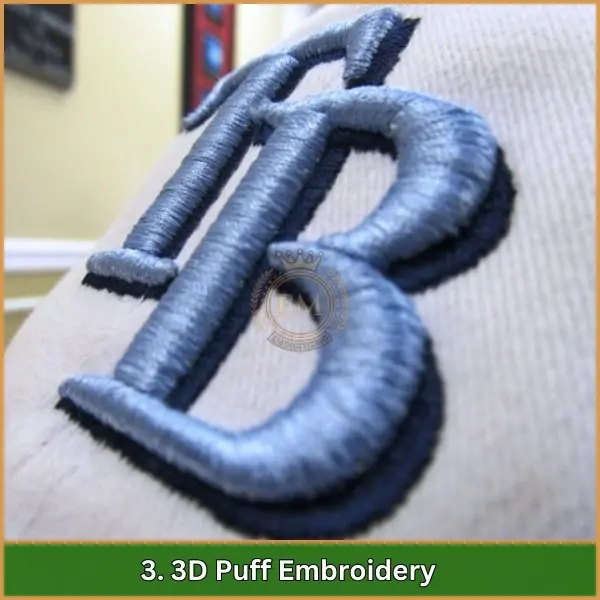
3El bordado puff D es un método en el que se coloca espuma debajo del área de costura antes de bordar..
Esta espuma levanta las costuras de la superficie., creando un audaz, efecto tridimensional.
Beneficios:
- Impacto visual sorprendente: El diseño elevado le da un toque audaz., efecto que llama la atención, lo que lo convierte en el favorito para gorras deportivas y artículos promocionales..
- Durabilidad: La espuma proporciona soporte adicional a las costuras., haciendo que el diseño bordado sea más duradero y resistente al desgaste.
- Textura: Agrega un elemento táctil al diseño., haciéndolo no sólo visualmente atractivo sino también interesante al tacto.
Características clave:
- Base de espuma: La espuma se coloca debajo del diseño antes de coser., creando una apariencia tridimensional.
- Densidad de puntada: Es necesario ajustar la densidad de la puntada para garantizar que la espuma esté completamente cubierta y que el diseño luzca suave y uniforme..
- Idoneidad del diseño: 3D puff bordado funciona mejor con simple, diseños atrevidos, como logotipos o texto grande, ya que los detalles intrincados pueden perderse en el efecto elevado.
Habilidades avanzadas de bordado para bordado de sombreros
Para aquellos que quieren traspasar los límites de sus habilidades de bordado., Vale la pena explorar estas técnicas avanzadas.:
- Punto de cruz en máquinas
- Bordado De Punto De Foto
- Bordado en el aro
1. Punto de cruz en máquinas
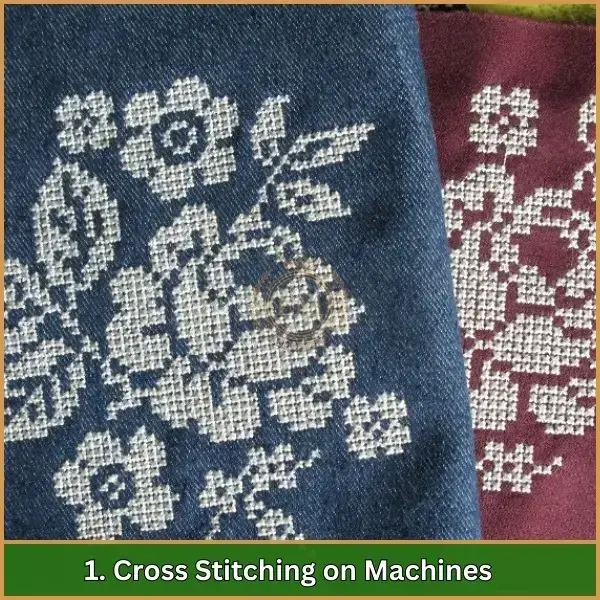
punto de cruz, tradicionalmente un bordado a mano método, Se puede adaptar a máquinas para crear diseños con un diseño único., apariencia texturizada. It involves making “;X”;-puntadas en forma, dando un aspecto tradicional pero elegante.
Beneficios:
- Apariencia texturizada: The “;X”; Las puntadas le dan al diseño un toque distintivo., textura cosida a mano, ideal para agregar profundidad y complejidad.
- Aspecto tradicional: Esto trae un clásico., sensación vintage en el diseño, haciéndolo destacar de otros estilos de bordado.
- Versatilidad: Adecuado tanto para patrones simples como complejos., permitiendo una amplia gama de posibilidades de diseño.
Características clave:
- Patrones de punto de cruz: La máquina imita el punto de cruz hecho a mano., creando un look artesanal.
- Juego de colores: Múltiple colores de hilo se puede utilizar para crear vibrantes, patrones intrincados.
- Variedad de diseño: Desde formas geométricas simples hasta complejas, diseños detallados, el punto de cruz ofrece una gran versatilidad.
2. Bordado De Punto De Foto
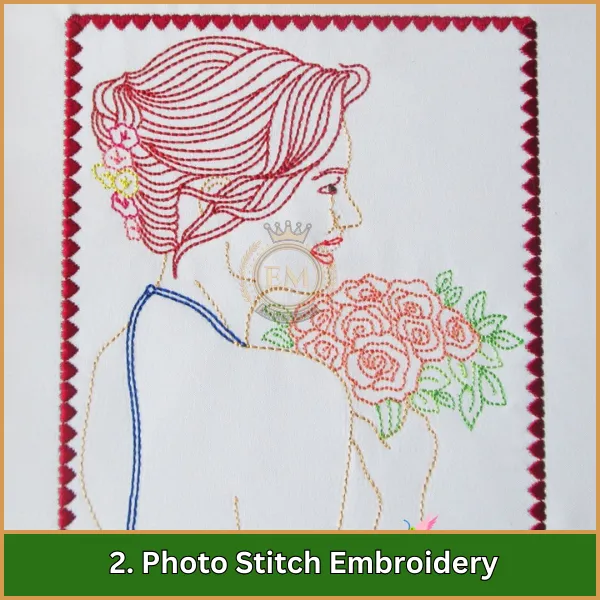
El bordado de puntadas fotográficas transforma imágenes de alta resolución en patrones de puntadas detallados. Esta técnica te permite bordar retratos realistas o imágenes detalladas en sombreros., creando un efecto fotorrealista.
Beneficios:
- Alto detalle: Capta detalles intrincados y degradados de color., haciéndolo perfecto para recrear fotos, logotipos, o diseños realistas.
- Diseños personalizados: Ideal para personalizar productos de sombreros con fotografías., logotipos detallados, o ilustraciones personalizadas.
- Aspecto profesional: La puntada fotográfica proporciona un acabado artístico y profesional., especialmente para pedidos personalizados.
Características clave:
- Conversión de imagen: Las imágenes de alta resolución se convierten en archivos de puntadas digitalizados., que luego se bordan sobre la tela.
- Complejidad de costura: La técnica requiere altos niveles de precisión y control de la máquina., ya que el diseño suele estar formado por miles de pequeños puntos.
- Ejecuciones de prueba: Se recomienda realizar pruebas en telas similares para garantizar que el diseño se traslade bien al sombrero y que los colores aparezcan con precisión..
3. Bordado en el aro
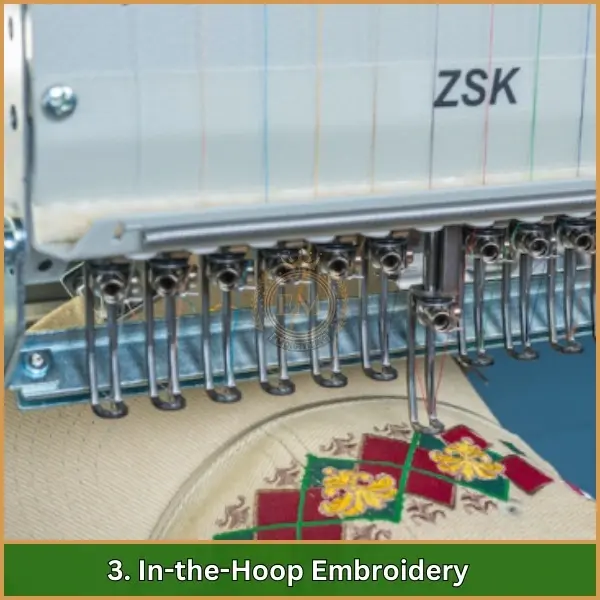
En el-bordado de aro Es una técnica en la que se completan proyectos completos dentro del bastidor de bordado., combinando múltiples pasos como coser, corte, e incluso añadiendo elementos funcionales como cremalleras.
Beneficios:
- Precisión: Mantiene la tela estable dentro del aro, Asegurar que los diseños estén bordados de forma precisa y consistente..
- Multifuncional: Permite la creación de proyectos complejos que van más allá del simple bordado., como agregar bolsillos, cremalleras, apliques de oro.
- Eficiencia: Combina varios pasos en un solo proyecto, reduciendo la necesidad de toques finales adicionales una vez finalizado el bordado.
Características clave:
- Costuras controladas: La tela permanece estable en el aro., permitiendo costuras precisas y menor riesgo de errores.
- Versatilidad del proyecto: Los proyectos dentro del aro pueden incluir elementos funcionales o decorativos., haciéndolo adecuado para crear algo más que diseños bordados.
- Planificación detallada: Esto requiere una cuidadosa planificación y digitalización del bordado., ya que todo el proyecto debe completarse dentro de los límites del aro de bordado.
Consejos profesionales para resultados excepcionales
Asegúrese de que su bordado destaque con estos consejos de expertos.
- Elegir los materiales adecuados: Invierte en hilos y estabilizadores de alta calidad que complementen el tipo de tela de tu gorro..
- Pruebas de digitalización y diseño: Digitalice con precisión sus diseños y realice pruebas en telas similares para evitar problemas durante el bordado final..
- Mantenimiento de equipos: Mantenga regularmente su Maquina de bordar para garantizar una calidad constante y evitar fallos mecánicos.
Línea de fondo
Bordar productos para la cabeza es una excelente manera de crear diseños únicos y personalizados.. Ya sea que estés empezando o trabajando con técnicas avanzadas, puedes crear sombreros de aspecto profesional con las habilidades adecuadas.
Del bordado básico al avanzado, La práctica te ayudará a mejorar y hacer que tus proyectos se destaquen..
Si quieres ahorrar tiempo y conseguir diseños perfectamente digitalizados para tus bordados, EMdigitalización está aquí para ayudar. Nuestro equipo de expertos puede convertir sus ideas en diseños de bordado listos para usar..
Más, estamos ofreciendo un 50% descuento para todos los clientes nuevos! Deje que EMdigitizing se encargue del trabajo técnico para que usted pueda concentrarse en su creatividad.
Pruebe EMdigitizing hoy y vea cómo podemos hacer que su proyectos de bordado más fácil y mejor!
preguntas frecuentes
Sí, Tanto los sombreros como las gorras entran en la categoría de sombrerería y accesorios para la cabeza.. La diferencia clave es que los sombreros siempre tienen un ala y una copa con forma., mientras que las mayúsculas están menos estructuradas, falta un ala, pero siempre cuentan con visera o visera.
Sombrero, sombreros, o tocado se refiere a cualquier prenda de vestir que se usa en la cabeza, incluyendo sombreros, cascos, turbantes, y otros tipos. Estos artículos se pueden usar como protección., decoración, razones religiosas o culturales, o seguir costumbres sociales.
- Lávate siempre las manos antes de comenzar un proyecto de bordado..
- Asegúrese de que los bordes del lienzo estén asegurados para evitar que se deshilache..
- Comience a bordar desde el centro de la diseño.
- Utilice un marcador específico para tela para crear una cuadrícula de 10/10 Células para guiar tu costura..
